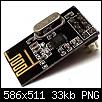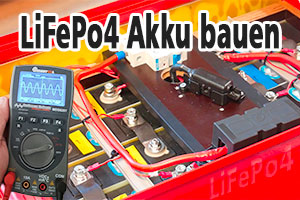Hallo Forum,
Ich habe eine kleine Testroutine für NRF24 Module an Arduino Nano am Laufen- Aufbau und Codes sind im Wesentlichen nach diesem Tutorial.
Mit zwei Standard-Power Modulen wie diesen hier:

Läuft die Übertragung problemlos.
Wenn ich aber auf der Sendeseite den HF-stärkeren "NRF24L01+PA" (seiehe Bild)

einsetze, ist Schluß mit lustig. Ich bekomme keine Übertragung hin.
Beide Module hängen an den 3,3V des jeweiligen Nano, parallel sitzt der empfohlene 10uF C. Die Pin-Beschaltung des Powermoduls ist offensichtlich gleich wie beim Standard-Power. Leider habe ich nur ein Datenblatt für den Standand finden können, nicht für den Powertyp.
Seltsam finde ich die Stromaufnahme: Standard-NRF + Arduino nehmen beim Einschalten für kurze Zeit ca. 27mA auf. Dann springt der Strom auf 40 mA und bleibt dort stabil. Wenn aber der Power-NRF am Nano hängt, ist so ein verzögerter "Anstieg" nicht erkennbar. Der Strom ist konstant ca. 35mA, also sogar niedriger als beim Standard-Typ??? 
Nachdem ich beim ersten Powermodul diesen Fehlschlag hatte, habe ich zwei weitere Exemplare bestellt. Alle drei sind allerdings in gleicher Weise "Arbeitsverweigerer".
Zur Vollständigkeit hier der Code für den Sendeteil;
Code:
/* Tranmsitter code for the Arduino Radio control with PWM output
* Install the NRF24 library to your IDE
* Upload this code to the Arduino UNO, NANO, Pro mini (5V,16MHz)
* Connect a NRF24 module to it:
Module // Arduino UNO,NANO
GND -> GND
Vcc -> 3.3V
CE -> D9
CSN -> D10
CLK -> D13
MOSI -> D11
MISO -> D12
This code transmits 1 channels with data from pins A0 POTENTIOMETER
Please, like share and subscribe : https://www.youtube.com/c/ELECTRONOOBS
*/
#include <SPI.h>
#include <nRF24L01.h>
#include <RF24.h>
const uint64_t my_radio_pipe = 0xE8E8F0F0E1LL; //Remember that this code should be the same for the receiver
RF24 radio(9, 10);
// The sizeof this struct should not exceed 32 bytes
struct Data_to_be_sent {
byte ch1;
};
Data_to_be_sent sent_data;
void setup()
{
radio.begin();
radio.setAutoAck(false);
radio.setDataRate(RF24_250KBPS);
radio.openWritingPipe(my_radio_pipe);
sent_data.ch1 = 127;
}
/**************************************************/
void loop()
{
/*If your channel is reversed, just swap 0 to 255 by 255 to 0 below
EXAMPLE:
Normal: data.ch1 = map( analogRead(A0), 0, 1024, 0, 255);
Reversed: data.ch1 = map( analogRead(A0), 0, 1024, 255, 0); */
sent_data.ch1 = map( analogRead(A0), 0, 1024, 0, 255);
radio.write(&sent_data, sizeof(Data_to_be_sent));
}
Und hier für den Empfänger:
Code:
/* Receiver code for the Arduino Radio control with PWM output
* Install the NRF24 library to your IDE
* Upload this code to the Arduino UNO, NANO, Pro mini (5V,16MHz)
* Connect a NRF24 module to it:
Module // Arduino UNO,NANO
GND -> GND
Vcc -> 3.3V
CE -> D9
CSN -> D10
CLK -> D13
MOSI -> D11
MISO -> D12
This code receive 1 channels and prints the value on the serial monitor
Please, like share and subscribe : https://www.youtube.com/c/ELECTRONOOBS
*/
#include <SPI.h>
#include <nRF24L01.h>
#include <RF24.h>
const uint64_t pipeIn = 0xE8E8F0F0E1LL; //Remember that this code is the same as in the transmitter
RF24 radio(9, 10); //CSN and CE pins
// The sizeof this struct should not exceed 32 bytes
struct Received_data {
byte ch1;
};
int ch1_value = 0;
Received_data received_data;
/**************************************************/
void setup()
{
Serial.begin(9600);
//We reset the received values
received_data.ch1 = 127;
//Once again, begin and radio configuration
radio.begin();
radio.setAutoAck(false);
radio.setDataRate(RF24_250KBPS);
radio.openReadingPipe(1,pipeIn);
//We start the radio comunication
radio.startListening();
}
/**************************************************/
unsigned long last_Time = 0;
//We create the function that will read the data each certain time
void receive_the_data()
{
while ( radio.available() ) {
radio.read(&received_data, sizeof(Received_data));
last_Time = millis(); //Here we receive the data
}
}
/**************************************************/
void loop()
{
//Receive the radio data
ch1_value = 0;
receive_the_data();
ch1_value = map(received_data.ch1,0,255,1000,2000);
Serial.println(ch1_value);
delay(500);
}//Loop end
Ich mag nicht recht glauben, dass ich drei defekte Module in zwei Lieferungen erwischt habe. Allerdings waren sie vom selben Lieferanten.
Irgendwelche Ideen von Euch, was das Problem sein könnte?
Gruß und schönes Wochenende
Uwe









 Zitieren
Zitieren


Lesezeichen